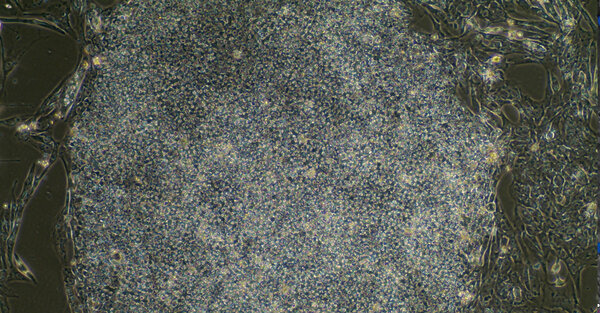

Genetics of Parkinson's disease: Analysis of genetic factors in hereditary and non-hereditary forms of Parkinson's disease
Parkinson's syndrome (PS) is the second most common neurodegenerative disease after Alzheimer's dementia. The vast majority of patients are ill with no apparent cause. In a small part of the patients (less than 5%) a clear heredity can be observed. Despite their rarity, the identification and functional analysis of the genes leading to these so-called "monogenic" forms of the disease has contributed significantly to the elucidation of the cellular mechanisms involved in disease development. It is assumed that so far only a small fraction of the causative genes has been found. However, the causes of the far more frequent non-hereditary forms of Parkinson's disease are still unknown. It is also assumed for this probably heterogeneous group of diseases that genetic factors play a not insignificant role, especially in the sense of influencing the risk of illness, the age of onset or the course of the disease. The first group of genome-wide association studies (GWAS) has already shown that variants in several genes, which have already been described as disease-related in familial forms of the disease, can also influence the risk for non-hereditary disease forms.
Dystonia
Dystonia is the third most common movement disorder, and mutations in a growing number of genes have been identified as causes for hereditary forms in many cases. The aim of the group, which brings together clinical experience in the diagnosis and treatment of the dystonias with expertise in molecular genetics, is to define the role of known genes in the etiology of dystonia, but especially to find new genes and therefore gain novel insight into the molecular pathogenesis of the disorder. Patient recruitment is based on the departmental outpatient clinic for botulinum toxin treatment led by Prof. Schöls, on international collaborations but also on the work of Dr. E.Lohmann, who is presently working at the University of Istanbul, supported by a Margarete von Wrangell-stipend. As Turkey is a country with a high rate consanguinity, the prevalence of hereditary recessive diseases is greatly increased. Building on an existing cohort of patients with dystonia from consanguineous families in Turkey,detailed phenotyping and a thorough work-up of the families will provide the basis for future genetic analyses.
Genetics of Parkinson's Disease
Genetic causes of the sporadic Parkinson's disease
The genetic variants known today can only explain a small part of the overall risk of disease. In order to obtain a more complete picture of the entire genetic risk profile and to derive new approaches for diagnosis, prevention or therapy, as complete genetic data sets as possible must be examined by many thousands of patients. In large international consortia, such as the International Parkinson's Disease Genomics Consortium (IPDGC), the research group conducts such studies in collaboration with many colleagues from around the world (Simon-Sanchez et al., Nat Genet, 2009, Nalls et al., Nat Genet 2014).
Contact: Prof. Dr. T. Gasser, Prof. D. Berg
Leucine rich repeat kinase 2, LRRK2 (Park8)
In 2004, the group was able to identify mutations in the LRRK2 gene (Leucine rich repeats kinase 2) in two large families with inherited Parkinson's disease (Zimprich et al., Neuron 2004). This discovery was taken up by many other groups around the world, and it turned out that LRRK2 mutations are the most common cause for autosomal dominant Parkinson's syndrome. Although all patients from affected families have mutations in the same gene, there is a remarkable heterogeneity both in terms of clinical appearance and neuropathological findings. For example, the spectrum of found protein aggregates of typical Lewy corpuscles or tau-positive neurofibrils suffices to the complete absence of both aggregate forms. The elucidation of the molecular pathomechanism of the disease caused by LRRK2 mutations could therefore be important for synucleinopathies (Lewy corpuscles) as well as for tauopathies (neurofibrils). This suggests a central role of the gene product in the pathogenesis of various neurodegenerative diseases with Parkinson's disease.
Contact: Prof. Dr. T. Gasser
Courage-PD: Comprehensive Unbiased Risk factor Assessement for Genetics and Environment in Parkinson‘s Disease
This multi-national project, funded under the "Joint Programming for Neurodegenerative Disease (JPND)", will combine genetic, epidemiological and cell biology approaches to contribute to a better understanding of the development of Parkinson's disease. Particular attention is paid to the interaction of genetic and environmental factors in the development of the disease. Risk factors are then examined in cell culture models based on the iPS (induced pluripotent stem cells) technology for their functional effects.
Contact: Prof. Dr. T. Gasser, Prof. Dr. R. Krüger, Dr. M. Sharma
Dystonia
The identification of ATP1A3 for rapid onset dystonia parkinsonism and MR-1 for paroxysmal non-kinesiogenic dyskinesia revealed interesting new insights into pathways of the brain that may be involved in dystonia development. The hitherto set thematic focus on the characterization of the genetic and molecular pathogenetic aspects of torsin A and epsilon sarkoglycan have been continued and intensified.
Myoclonus-dystonia
Genetics and molecular pathogenesis of myoclonus dystonia
Myoclonus dystonia (M-D, DYT11) is a dystonia-plus syndrome, in which the patients suffer from focal or segmental dystonia in addition to "lightning" myoclonia.
Our previous mutation screening demonstrated heterozygous exonian mutations in the gene for epsilon sarkoglycan (SGCE) in over 80% of familial cases. Genetic heterogeneity has also been assumed for the other families, which is supported by the mapping of an alternative gene locus on chromosome 18 (DYT15)(Grimes et al 2002).
However, the etiology of the sporadic, almost in all cases, mutation-negative cases of SGCE is still insufficiently understood. We analyzed the promoter sequence of 40 sporadic patients who clinically met the criteria of myoclonus dystonia. It was found that the promoter region is highly conserved. Only a few SNP variations could be found. In the next step, the effect of these polymorphisms on the SGCE expression level will be investigated by luciferase assays.
No role is played by SGCE in the pathogenesis of sporadic Gilles de la Tourette cases in a cohort of 83 German index patients. Exonian mutations could be excluded. There was no evidence for a genetic association of GTS with the 7q21 region. The molecular biology work on the generation of a conditional mouse model for SGCE was continued and further protein-chemical phenotyping experiments were established. The cooperation with the Neurological Clinic of LMU, Munich (Prof. Dr. T. Brandt, Dr. A. Deutschländer) was continued with Voxel-based morphometry (VBM) investigations. Interestingly, with this volumetric method, similar regions of interest are found as with the functional nuclear spin measurements. These are frontal cortical and subcortical structures involving the thalamus.
Current theses
Scientific theses
- Claudia Schulte
Untersuchung der genetischen Ursachen des Parkinsonsyndroms
Prof. Dr. T. Gasser - Julia Sekler
Expression von SNCA im Hinblick auf die molekulare Entstehung der Parkinson Krankheit
Prof. Dr. T. Gasser - David Schöndorf
Modeling Parkinson's Disease using genome editing in human induced pluripotent stem cells
Prof. Dr. T. Gasser
Medical theses
- Norbert Silimon
Untersuchung des Einflusses von SNCA-Rep1 auf das Erkrankungsalter und klinische Parameter bei Patienten mit idiopathischem Parkinson-Syndrom
Prof. Dr. T. Gasser - Steffen Brenner
Genetische Untersuchungen zur α-Synuklein-Expression
Prof. Dr. T. Gasser
Completed theses
- Michela Deleidi
In vitro and in vivo modelling of Parkinson's disease using induced pluripotent stem cells
Prof. Dr. T. Gasser - Benjamin Schmid
Establishment and characterization of a human in vitro cell model for Parkinson’s disease
Prof. Dr. T. Gasser - Marta Garcia-Morales
Cellular phenotypes associated with LRRK2-mutations
Dr. Saskia Biskup - Rebecca Gottorf
Analyse der relativen Genexpression von LRRK2 und {alpha}-Synuclein in humanem Vollblut mittels
quantitativer real time RT-PCR in einem heterogenen Probandenkollektiv aus Parkinsonpatienten, symptomatischen und symptomatischen LRRK2-Mutationsträgern und Kontrollen
Dr. Saskia Biskup, Dr. Martina Wölfle - Oliver Rothfuss
Funktionelle Charakterisierung des Parkin-Gens
Dr. Nadja Patenge - Manu Sharma
Genetic Epidemiology of Parkinson's Disease: approaches for Gene mapping
Prof. Dr. T. Gasser, Dr. B. Müller-Myhsok - Julia Fuchs
Genetic risk factors and their functional implications in Parkinson’s disesase
Prof. Dr. T. Gasser

Center of Neurology
Hertie Institute for Clinical Brain Research
Department Neurodegenerative Diseases
Hoppe-Seyler-Straße 3
72076 Tübingen
Phone: +49 (0)7071 29-86529
Fax: +49 (0)7071 29-4839
Isolde Marterer
Phone: +49 (0)7071 29-82048
isolde.marterer@med.uni-tuebingen.de
Dr. Angelika Oehmig
Miriam Peleman
Petra Mech
Otfried-Müller-Straße 27
Phone: +49 (0)7071 29-87640







